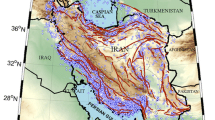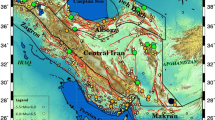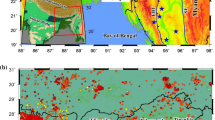Abstract
North-east India is seismically very active and has experienced many widelydistributed shallow, large earthquakes. Earthquake generation model for the region was studied using seismicity data [(1906–1984) prepared by National Geophysical Data Centre (NGDC), Boulder Colorado, USA]. For establishing statistical relations surface wave magnitudes (M s≥5·5) have been considered. In the region four seismogenic sources have been identified which show the occurrences of atleast three earthquakes of magnitude 5·5≤M s≤7·5 giving two repeat times. It is observed that the time interval between the two consecutive main shock depends on the preceding main shock magnitude (M p) and not on the following main shock magnitude (M f) revealing the validity of time predictable model for the region. Linear relation between logarithm of repeat time (T) and preceding main shock magnitude (M p) is established in the form of logT=cM p+a. The values ofc anda are estimated to be 0–36 and 1–23, respectively. The relation may be used for seismic hazard evaluation in the region.
Similar content being viewed by others
References
Anagnos T and Kiremidjian A S 1984 Stochastic time-predictable model for earthquake occurrences;Bull. Seismol. Soc. Am. 74 2593–2611
Astiz L and Kanamori H 1984 An earthquake doublet in Ometepec, Guerrero, Mexico;Phys. Earth Planet. Int. 34 24–25
Bufe C G, Harsh P W and Burford R O 1977 Steady-state seismic slip—a precise recurrence model;Geophys. Res. Lett. 4 91–94
Chen W P and Molnar P 1977 Seismic moments of major earthquakes and the average rate of slip in Central Asia;J. Geophys. Res. 82 2945–2969
Cornell C A 1968 Engineering seismic risk analysis;Bull. Seismol. Soc. Am. 58 1583–1606
Fitch T J 1970 Earthquake mechanisms of the Himalayan, Burmese and Andaman regions and continental tectonics in Central Asia;J. Geophys. Res. 75 2699–2709
Gardner J K and Knopoff L 1974 Is the sequence of earthquake in southern California with aftershocks removed Poissonian?Bull. Seismol. Soc. Am. 64 1363–1368
Hanks T C and Kanamori H 1979 A moment magnitude scale;J. Geophys. Res. 84 2348–2350
Kiremidjian A S and Anagnos T 1984 Stochastic slip predictable model for earthquake occurrences;Bull. Seismol. Soc. Am. 74 739–755
McNally K C and Minster J B 1981 Nonuniform seismic slip rates along the middle America, trench;J. Geophys. Res. 86 4949–4959
Molnar P and Tapponnier P 1978 Active tectonics of Tibet;J. Geophys. Res. 83 5361–5375
Molnar P and Chen W P 1983 Focal depth and fault plane solutions of earthquakes under the Tibetan plateau;J. Geophys. Res 88 1180–1186
Nishenko S P and Singh S K 1987 Conditional probabilities for the recurrence of large and great intraplate earthquakes along the Mexican subduction zone;Bull. Seismol. Soc. Am. 77 2095–2114
Papadopoulos G A and Voidomatis P 1987 Evidence for periodic seismicity in the inner Aegean Seismic Zone;Pure Appl. Geophys.125 613–628
Papazachos B C 1989 A time predictable model for earthquake generation in Greece;Bull. Seismol. Soc. Am.79 77–84
Purcaru G and Berckhemer H 1978 A magnitude scale for very large earthquakes;Tectonophysics 49 189–198
Shimazaki K and Nakata T 1980 Time-predictable recurrence model for large earthquakes;Geophys. Res. Lett.7 279–282
Singh S K, Astiz L and Havskov J 1981 Seismic gaps and recurrence periods of large earthquakes along the Mexican subduction zone-are-examination;Bull. Seismol. Soc. Am.,71 827–843
Verma R K, Mukhopadhyay M and Nag A K 1980 Seismicity and tectonics in south China and Burma;Tectonophysics 64 85–96
Verma R K and Kumar G V A K 1987 Seismicity and nature of plate movement along the Himalayan arc, North-east India and Arakan-Yoma;Tectonophysics 134 153–175
Wallace R E 1970 Earthquake recurrence intervals on the San Andreas fault;Geol. Soc. Am. Bull. 81 2875–2890
Wang S C, McNally K C and Geller R J 1982 Seismic strain release along the middle America Trench, Mexico;Geophys. Res. Lett.9 182–185
Author information
Authors and Affiliations
Rights and permissions
About this article
Cite this article
Singh, V.P., Shanker, D. & Singh, J. On the validity of time-predictable model for earthquake generation in north-east India. Proc. Indian Acad. Sci. (Earth Planet Sci.) 101, 361–368 (1992). https://doi.org/10.1007/BF02893011
Received:
Revised:
Issue Date:
DOI: https://doi.org/10.1007/BF02893011




